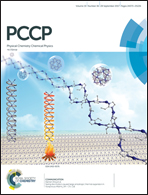Structure relaxation via long trajectories made stable†
Abstract
Molecular dynamics (MD) is appearing in increasing applications in materials science, nanotechnologies, condensed matter physics, computational physics, biochemistry, and biophysics. Finding mechanically static equilibrium configurations of molecular systems is one of the most practical tasks in MD. Most existing potential energy optimization algorithms do not permit searching equilibrium configurations through longer MD trajectories. We introduce a simple method of utilizing a microcanonical (NVE) ensemble to obtain static equilibriums of molecular systems, that is significantly faster than the standard implementations of quick-min (QM) and fast inertial relaxation engine (FIRE) optimization algorithms. The new method is based on the capability of NVE to convert potential energy to kinetic energy. The surprising efficiency of the method is illustrated using an indentation test on monolayer graphene and, in particular, the versatility of the method is illustrated using relaxation of a polystyrene chain through longer MD trajectories and large deformation. The capability of the new method in finding more stable equilibrium configurations than common optimization algorithms is demonstrated in relaxation of a pressured lubricating oil layer and a warped monolayer graphene cantilever.



 Please wait while we load your content...
Please wait while we load your content...